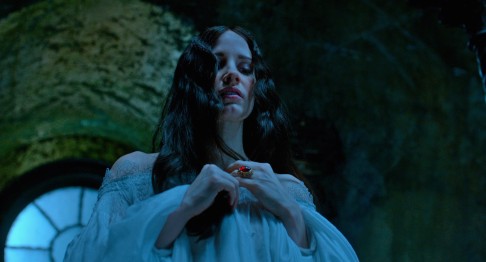
Guillermo del Toro's Crimson Peak is horror with a painterly look
'I need to identify with the characters in every movie, the good guys and the bad guys,' says director
Guillermo del Toro has a bizarre request for his travel agent: book him, if possible, in haunted hotels. There was the five-star one in London, known for its regular ghost sightings. And then one in New Zealand, where del Toro stayed while scouting locations for films, when he had an other-worldly visitation.
"I heard a murder at 1am, a woman screaming horribly. And then I saw a man sobbing with regret. It was off season and we were only eight people staying in the hotel and I was the only one in that wing. I was super scared. I was watching on DVD, not invoking ghosts with a candle. I put my earphones on, watched the entire season, and didn't sleep a single minute."
Del Toro's love of the occult, which stems from his earliest childhood, is evidenced in many of his films, from the creepy to the outright terrifying , about two young girls abandoned in a desolate forest cabin.
The award-winning filmmaker may have his older brother to thank for his affinity with all things scary: the two of them were watching a TV show called , an episode called , about a big-headed giant-eyed monster. Later that night, del Toro's brother stuck some pantyhose over his head, put rubber eggs into his eye sockets, and crept into his younger sibling's room, screaming.
"I literally lost control of my bladder," he says. "Psychologists talk about a mechanism that occurs in childhood where you identify with whatever scares you and you end up sometimes enshrining it. For me, it happened with monsters. I've always been in love with them."
There's more than a few monstrous characters in his latest offering, , a romantic Gothic horror tale that del Toro wrote and directed. It has all the typical horror tropes - door handles turning, figures dissipating into black smoke, bloody hands rising through creaky floorboards.

But because it is visually gorgeous - a resplendent Jessica Chastain in silk brocades, the dashing Tom Hiddleston in tailcoat and exquisite manners, an ethereal Mia Wasikowska in billowy white nightdress, all living in a once-regal hilltop home - is also utterly, unexpectedly macabre. Del Toro says that the movie's look was inspired "more by paintings and drawings and books than other movies".
He was moved by the work of Victorian-era artist John Atkinson Grimshaw, noted for his subtly eerie moonlit landscapes. "We tried to make everything rhyme - the wardrobe with the set with the camera style - to make it a little bit like a moving painting."
The filmmaker has long collected Gothic romance "as a tangential interest of horror literature". He wanted this story to be predicated on that sensibility, what he describes as "a journey into darkness through the romance of a dark brooding gentleman".

Sharpe's sister is Lady Lucille (Chastain) - uptight, beautiful and with a mysterious axe to grind. They move to, of course, a crumbling mansion in cold and rural northern England, which, as it turns out, has a life of its own: it breathes, bleeds, talks, remembers, and wreaks all sorts of havoc on the newlyweds.
So fanatical is del Toro about the characters he writes that he creates exhaustively detailed biographies for them; it doesn't matter what you don't see on screen (such as the fact that Lady Lucille hates the taste of bitter chocolate). For him, a character can only fully come to life if he knows everything about him or her - the colours they like, the music they respond to.
"I need to identify with the characters in every movie, the good guys and the bad guys," he says. "I write them all from myself or from people I know." He brings out astrology books, medicine books, tomes on the Chinese zodiac, and starts mapping out character traits: if this person was born in the year of the dragon, then he would have a certain personality.
There is as well a compelling emotional core to the story, which examines the relationship between husband and wife, brother and sister, sister and sister-in-law.

Chastain says she had to go the extra mile to really get into the head of her character. She contacted the production and costume designers and asked them to give her images with which she papered the walls of her trailer.
"I singled out photos I thought would help me relate to Lucille and what was going on in her subconscious," she says. "Pictures of little boys and girls, disturbing modern art and Gothic images … they were scary, and when you look at them they put you on edge."
She found del Toro's comprehensive bio invaluable in allowing her to truly tap into the character. "I connected with her need for intimacy and found her to be an incredibly lonely woman - who at the end of the day wanted to feel love and intimacy, but she's the one holding it away from herself."

She particularly relates to del Toro's vision of Lucille as always needing to be in restricting clothing. "It was like her emotions had to be contained," she says. "If she was wearing things that were more flowing and loose, she'd be like a big exposed nerve. I thought it interesting to think about what happens when she's freed from that. What is she hiding?"
It's a question that permeates the film. Del Toro was cautious not to give too much away, except to say that to him, the horror genre works best when it's not just about good versus evil. "I don't like to connect them with moral or religious superstructures," he says. "I'm not interested in that."
opens on October 15

